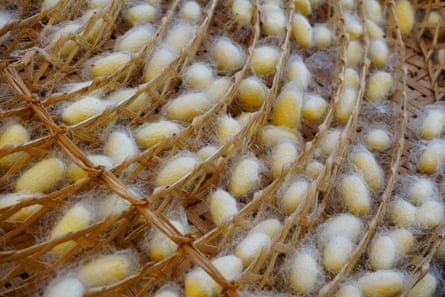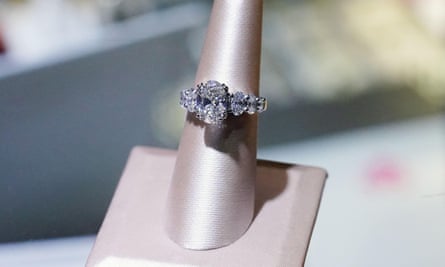
Developing cleaner sources for raw materials is essential to reducing fashion’s (alarming) contribution to global heating.
With this in mind start-ups and scientists are racing to recreate diamonds, silk and leather in laboratories.
If they can succeed, at scale, it will make a difference says Christine Goulay, founder of Sustainabelle Advisory Services. “Lab-grown materials can help eliminate supply chain risks related to human rights, animal welfare, and biodiversity loss.”
But that is a very big “if”. Nina Marenzi, founder of Future Fabrics Expo which will take place in London this month, says as lab-grown materials come to market, it is vital to ask the right questions – otherwise they will wind up perpetuating the problems they were meant to solve.
Synthesised silk
Traditional silk relies on a process known as sericulture where silkworms are raised until they have cocooned, then they are boiled, killing the moth inside. After this, the silk is extracted from the cocoon. A lab-grown alternative is appealing from an animal cruelty perspective, and may use less energy than industrial silk production.
A few years ago, a textile called Microsilk started getting attention in the industry. Developed by Bolt Threads (which also produce Mylo, a vegan leather), it is brewed in a lab using a technique called precision fermentation. Genetically modified yeast cells are mixed with sugar and water, and this mixture is left to ferment in large tanks until it becomes a liquid protein that can be extracted, spun then woven into a textile.
Like silk, the fabric is a protein, and it shares some physical properties with real silk: it is lightweight, smooth and biodegradable. Between 2016 and 2019 the company that makes Microsilk received a $700 million evaluation; made two dresses in collaboration with Stella McCartney; and released a tie and beanie under its own label.
But currently there are no Microsilk products on the market. This is because subtle changes in temperature and pH levels can upset the fermentation process, which makes it difficult to produce at scale.
Even if these issues can be ironed out, Marenzi has concerns about the ingredients used to brew the silk. The main input is sugar, which typically comes from corn, which is generally grown as a genetically modified monocrop.
In an ideal world, the inputs required to brew the protein – which are known as feedstocks – would not come from industrial agricultural systems where monocultures and the use of synthetic fertilizers and pesticides are prevalent, and pose a threat to biodiversity. Tara St James, senior director of sustainability at Canadian outerwear brand Moose Knuckles points out it’s worth considering whether feedstocks could be put to better use: like energy or food.

Brewed Protein is another material emerging in this space – also made through precision fermentation. It is produced by Japanese company Spiber Inc, and can be made into a variety of textures including fleece, denim and fur. The company combines synthesised DNA with a feedstock of sugar and corn. Their website outlines a desire to move to circular inputs, and improve the way their corn and sugar are farmed. In 2022 Spiber Inc started building its first large-scale plant, in Thailand. They have released a very limited run of products with The North Face and Junya Watanabe, and there is currently a 12% Brewed Protein, 88% cotton hoodie for sale from Pangaia for A$625.
Lab-grown leather
Not to be confused with the many vegan leather alternatives already on the market, scientists are working on leather cultivated in a lab using cells of animal origin.
The resulting hides should share the properties of real leather: a combination of fat, protein, breathability and flexibility that has to date been basically impossible to replicate using plants or plastic.
Goulay says by “replicating the structure of skin and using the same type of collagen” lab-grown leathers are able “to get as close as possible to their naturally occurring counterparts”.

There are a few companies working in this space, including New Jersey-based Modern Meadow, and California-based VitroLabs, which received a $46m series-A funding round last year from investors including luxury conglomerate Kering.
To cultivate their leather, VitroLabs takes a small biopsy from a real cow and combines the harvested cells with nutrients to grow sheets of leather that then go through a simplified tanning process. VitroLabs says the nutrients consist of amino acids, proteins, carbohydrates and vitamins that are sourced from commercial vendors.
While VitroLabs’ pilot manufacturing facility has been in operation for about a year, and are actively seeking partnerships with businesses, there are no items on the market yet.
If lab-grown meat’s slow journey to market is any indication, a commercially viable product could be a long time away – although it will likely face fewer regulatory hurdles since it is intended for wearing, not eating.
St James says using fewer animal products reduces issues around “resource extraction, risks to biodiversity degradation, animal cruelty, and links to deforestation issues in the supply chain”.
Since these products are nascent, Goulay says: “It’s really hard to make any sweeping declarations about one thing being more ‘sustainable’ than another … Just because something is lab-grown doesn’t eliminate the need to collect and analyse data.”
Meanwhile, those wondering exactly how many cows it takes to lab-grow leather should note that foetal bovine serum is widely used in cell cultivation.
No-mine diamonds
Lab-grown diamonds are already widely commercially available. Unlike natural diamonds, which were forged billions of years ago under intense pressure and heat from the earth, the lab-grown versions develop much faster, through processes that replicate these conditions.
The result is “chemically identical to naturally mined stones,” Goulay says. “It’s incredibly difficult to tell the difference.”
The Natural Diamond Council disputes this, and claims all laboratory diamonds can be detected using professional verification equipment.
“Lab-grown diamonds remove concerns related to conflict minerals and the huge potential negative environmental impacts of mining,” Goulay says. However, there are concerns about the amount of energy it takes to produce them.

Livia Firth, founder of Eco-Age, says sustainability claims made by lab-grown-diamond companies should be questioned. “Lab-grown diamonds and diamonds are two completely different things. And they equally have rights to exist. But I’m not sure lab-grown diamonds are more sustainable.”
She says many factories’ claims around renewable energy are likely overblown. “Solar panels are not able to power the entire factory,” she says. Sometimes it’s “just 10%.”
Firth says the traditional diamond trade does not always deserve its unethical reputation, and can provide significant livelihoods for communities that rely on it. She visited diamond mines in Botswana for a documentary series released in 2020, and says “every single person from the school teacher to the truck driver, to the shop owner, to the restaurant waiter, tells you how proud they are to be a product of their economy, a product of the diamond industry.”
Firth also believes the mass production of lab-grown diamonds does nothing to address the issue at the heart of fashion’s carbon footprint: overconsumption.
People get “engaged with a ring that belongs to their grandmother, you pass diamonds down,” she says. “You don’t buy a new diamond many times.”



